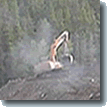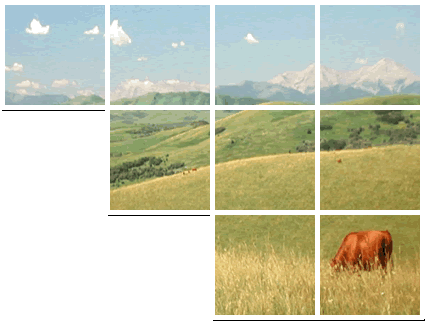 |
 |
|
















|
|
"Whiskey is for drinking, water is for fighting over." - Mark Twain
Water means life and prosperity. We use it every day and we use a lot of it. When we turn the tap we expect clean water to fill our glass, drive our industry, or provide water for agriculture. Yet we are running out of this precious resource and we need to start thinking about the key source of it - our Alberta watersheds.
Protecting our watersheds is tantamount to protecting our way of life. Scientists are saying that the potential for climate change may bring more extreme droughts. Thus we need to ensure that watersheds like the Pekisko Rangeland are safe from harm.
In fact, these watersheds and the work they do are in jeopardy from residential subdivision, increased recreation demands, coal mining, seismic testing, natural gas and Coal Bed Methane development.
|

Learn new interesting facts that might surprise you!
|
|
 Photo: Diana Rung, ACA
Riparian Zones
|
Watersheds are those geographic areas that capture and store water, releasing it slowly into rivers and underground aquifers. The alignment and height of the Rocky Mountains causes them to intercept winds, producing precipitation and making the Eastern Slopes a major water-gathering system for Southern Alberta.
Water quality increases as it passes through healthy watersheds. Vegetation and soil absorbs water and filters out pollutants. Aeration in fast-flowing streams destroys parasites and bacteria. Water flowing over rocks picks up essential minerals such as calcium and phosphorus.1 The native grasses in the rangeland are particularly good at maintaining healthy watersheds.
The Pekisko Lands are a key part of the watershed supplying Southern Alberta through the Highwood, Willow Creek and Oldman Rivers. The ranchers who live and work in the rangelands appreciate the role of their land as part of these key watersheds and respect the riparian zones that are such an important element of watershed health.
|
|
Riparian Zones are the lands adjacent to streams, rivers, lakes and wetlands, where the vegetation and soils are strongly influenced by the presence of water. Although they make up only a small fraction of the land, they are among the most productive and valuable of all landscape types. They come in all shapes and sizes and typically have special vegetation.
When riparian areas are healthy and properly functioning they provide many desirable functions in the watershed. These include maintaining water quality and quantity, preventing bank and shoreline erosion, filtering nutrients and pollutants so they don't enter the waterbody, and providing wildlife and fish habitat.
|
The map below illustrates the three major watershed areas draining the Pekisko Lands: the Highwood River system, the Willow Creek system, and the Oldman River system, all of which form part of the South Saskatchewan River watershed. Many other rivers in Alberta originate in the mountains and get a significant amount of their water from glaciers and snowmelt well into the summer. But these three watershed systems get most of their water from the foothills and are far more dependent on rain and groundwater to maintain flow levels. Thus healthy grasslands that capture, clean and release the water slowly in these watersheds are essential to wildlife, irrigation, local towns, ranching, and even cities.
The Pekisko Group is one of the Watersheds of Alberta community groups.
|
|
 |
Threats to these Watersheds
|
There are a number of threats to the watersheds in the Pekisko Lands, primary of which is the desire of the Oil and Gas industry to explore for sour gas and Coal Bed Methane deposits which may exist there.
Specifically:
Residential subdivision degrades Ecological Services. There are always people who want to live in rural subdivisions and developers who view the foothills as a place to make money on residential development. Such developments bring demands for water wells, roads, and related activities, all of which will ultimately degrade the watershed. Land use planning needs to limit such development and protect the large ranches that have operated to protect the native grassland and watershed integrity. Recreation, especially motorized, damages streams and wildlife habitat. As the population of Alberta increases the citizens of large cities such as Calgary demand more recreational opportunities. Land use controls must be maintained and even increased to ensure that the watershed cover, and especially the native grassland, is protected. Coal mining using open-pit methods is a known source of water pollution. Other similar mines not far away in British Columbia have been shown to leach excessive amounts of selenium into waterways. Such mining is even worse than oil and gas drilling because it has such a negative impact on watersheds - essentially destroying them. Communities, people, and agriculture downstream are affected not just by the water pollution but also by the fact that such mining uses a great deal of water, thus leaving less to the existing users downstream. The construction of access roads, well pads, compressor pads and pipelines can destroy native fescue grasslands which, to date, no science has found a way to effectively replace over these large areas. The lack of these native fescue grasses compromises the ability of the grasslands in their watershed function. The shock waves from seismic testing may alter the porous geology on which aquifers depend, and thus exising clear water springs. Venting or flaring of gas and liquids can release a number of gases which in combination with rain may pollute the soil and surface water. Mercury is of particular concern. Hydrocarbon extraction from non-conventional formations such as coals beds and shales is improved by fracturing the formation (frac'ing) using various noxious liquids under very high pressure. Not all of this liquid is recovered. Geologists can give no guarantee that the remaining noxious fluid will not find its way through cracks and into the groundwater above. Frac'ing is a therefore a threat to aquifers under the foothills.
Development of Coal Bed Methane involves drilling many holes into a coal seam and drawing off any water that may be there. If the water is too saline it is re-injected into deep holes. Due to the type of geology under the Western Slopes and lack of knowledge about aquifers there is no certainty that the disturbance of the coal beds and the re-injection of saline water will not effect existing wells and springs used by wildlife and ranching.
|
 |
|
|
|
|

